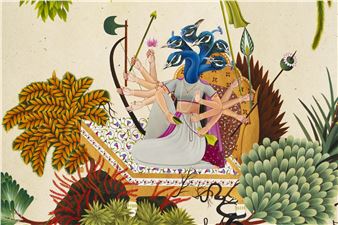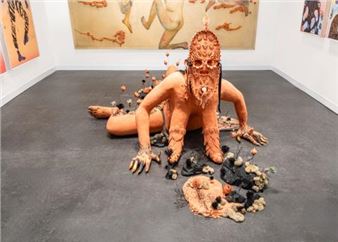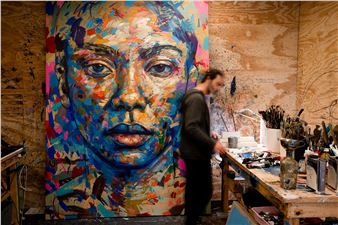Thresholds
Thresholds features multidisciplinary work by 18 artists: Daniel Levi, Belinda Blignaut, Patrick Bongoy, Simphiwe Buthelezi, Zarah Cassim, Amine El Gotaibi, Madoda Fani, Alexandra Karakashian, Nthabiseng Kekana, Nozuko Madokwe, Justine Mahoney, Thero Makepe, Rochelle Webster Nembhard, Mmangaliso Nzuza, Mankebe Seakgoe, Gemma Shepherd, Lulama Wolf and Luyanda Zindela.
Whether confronting the spectral weight of geopolitical borders or conjuring imagined terrains that destabilise the notion of ŌĆśterritoryŌĆÖ, the exhibition brings land and place into focus. Here, land is neither static nor inert ŌĆō it is contested, fluid, charged with histories of displacement, belonging, and transformation.
The landscape has historically operated within the Western canon as a site for the projection of cultural ideals of beauty, ownership and dominion. Often employed to illustrate allegory within stylised and constructed visions of harmony and order, the genre functioned as both aesthetic spectacle and ideological apparatus, frequently erasing the presence of labour, indigenous life, or colonial violence from the frame. South AfricaŌĆÖs history of landscape painting cannot be disentangled from colonial dispossession, Apartheid spatial politics, and indigenous cosmologies of land. Through this lens, earth is not to be claimed, aestheticised or extracted from. It is not neutral or decorative but politically charged and imbued with spirit, trauma and longing.
Many of the exhibitionŌĆÖs works embrace the transformative potential of organic matter and ancestral materials, exploring the ecological and social instabilities of the present through acts of making that are both political and devotional. Using icansi (reed mats), glass beads, tankrali (ancient Zulu seedbeads), seasand, seashells, and metal, Simphiwe Buthelezi crafts immersive, tactile abstractions that function as mnemonic landscapes. Intuitively navigating themes of community and nationhood, the artist gestures toward a desire to relocate the self, to return to a familiar place, whether real, invented, or symbolic. Like Buthelezi, Nozuko Madokwe positions her practice as a site of return, an energetic conduit for reconnection with earth and divine genesis. Her process, part alchemical, part ritual, begins with pilgrimages to Cape TownŌĆÖs local mountains, where she gathers rocks and sediment that are ground into richly pigmented powders and paints. The resulting works emerge through a gestural vocabulary of smudging, folding, and scattering, ultimately collapsing the boundaries between body, land, and spirit.

Recommended for you
Thresholds features multidisciplinary work by 18 artists: Daniel Levi, Belinda Blignaut, Patrick Bongoy, Simphiwe Buthelezi, Zarah Cassim, Amine El Gotaibi, Madoda Fani, Alexandra Karakashian, Nthabiseng Kekana, Nozuko Madokwe, Justine Mahoney, Thero Makepe, Rochelle Webster Nembhard, Mmangaliso Nzuza, Mankebe Seakgoe, Gemma Shepherd, Lulama Wolf and Luyanda Zindela.
Whether confronting the spectral weight of geopolitical borders or conjuring imagined terrains that destabilise the notion of ŌĆśterritoryŌĆÖ, the exhibition brings land and place into focus. Here, land is neither static nor inert ŌĆō it is contested, fluid, charged with histories of displacement, belonging, and transformation.
The landscape has historically operated within the Western canon as a site for the projection of cultural ideals of beauty, ownership and dominion. Often employed to illustrate allegory within stylised and constructed visions of harmony and order, the genre functioned as both aesthetic spectacle and ideological apparatus, frequently erasing the presence of labour, indigenous life, or colonial violence from the frame. South AfricaŌĆÖs history of landscape painting cannot be disentangled from colonial dispossession, Apartheid spatial politics, and indigenous cosmologies of land. Through this lens, earth is not to be claimed, aestheticised or extracted from. It is not neutral or decorative but politically charged and imbued with spirit, trauma and longing.
Many of the exhibitionŌĆÖs works embrace the transformative potential of organic matter and ancestral materials, exploring the ecological and social instabilities of the present through acts of making that are both political and devotional. Using icansi (reed mats), glass beads, tankrali (ancient Zulu seedbeads), seasand, seashells, and metal, Simphiwe Buthelezi crafts immersive, tactile abstractions that function as mnemonic landscapes. Intuitively navigating themes of community and nationhood, the artist gestures toward a desire to relocate the self, to return to a familiar place, whether real, invented, or symbolic. Like Buthelezi, Nozuko Madokwe positions her practice as a site of return, an energetic conduit for reconnection with earth and divine genesis. Her process, part alchemical, part ritual, begins with pilgrimages to Cape TownŌĆÖs local mountains, where she gathers rocks and sediment that are ground into richly pigmented powders and paints. The resulting works emerge through a gestural vocabulary of smudging, folding, and scattering, ultimately collapsing the boundaries between body, land, and spirit.
Artists on show
Related articles
Southern Guild Cape Town presents Thresholds, a group exhibition welcoming the multidisciplinary work of 18 contemporary artists.
The desert was always there, a patient white animal, waiting for men to die, for civilizations to flicker and pass into darkness.

 ARTISTS
ARTISTS
















